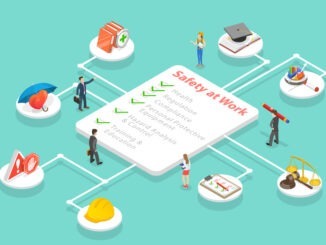
https://edexec.co.uk/the-sbl-state-of-the-nation/(opens in a new tab)
Laura Williams, school leadership coach, trainer and SBL podcast host, explains what exactly a SBL ‘state of the nation’ is, and why you should be doing it.
Read the full article below or on page 20 in our May magazine
When the overwhelm kicks in (which it inevitably does) our first instinct as a SBL is to keep running headlong into the fray, cape billowing and sword scything through anything that threatens to stop us.
We do this in the vain hope that, at some point, we’ll reach the end of the jungle and find ourselves standing on a tranquil, white, sandy beach with calm, crystal clear seas lapping at the shore.
However, what usually happens is we run out of puff as the seemingly endless jungle just gets darker and thicker, or we reach what we think is the idyllic slice of sand and instead find ourselves teetering on the edge of a mountain about to go over on a mudslide.
The life of an SBL, eh?
When the crazy becomes chaos, and the overwhelm becomes truly overwhelming, the thing I advise SBLs to do is something that goes against every natural instinct that we have.
Stop.
Stop right where you are.
Ignore the emails, shut your door, switch off the ‘phone and just stop.
Not just for a cup of tea – though I’m sure that will help too – but to do something that I like to call a ‘state of the nation’.
To me, in SBL world, a ‘state of the nation’ is a work-appropriate way to refer to what is otherwise known as getting your *bleep* together and regrouping!
- You don’t know what you should be doing right now if there is too much to do.
- You don’t know if you’re doing the right things when technically they are ALL the right things.
- You don’t know if everything on your list is really your job or something that you should be dealing with right now if you don’t know everything that is on your list.
- You don’t know if you’re going to miss a deadline if you only know some of them, not all of them.
Ultimately, if you can’t see everything from where you’re sitting, if you don’t know the true state of your nation, then you may well end up going over the edge of the mountain on that mudslide.
Here’s a quick process I use and recommend to other SBLs.
Step 1: Gather everything together
If you have jobs flagged in your inbox, tasks listed in a task app, post-its stuck to your monitor, notes scribbled in your diary, an Excel sheet of ‘projects’ colour-coded and tabbed by department, and a random file of papers on the end of your desk that you know you need to get to but never open… sweep off your desk, get a blank sheet of A4 and take one clump of stuff at a time and start making a list (I used to find a whiteboard good for this too – made me feel like Carol Vorderman!)
Step 2: Assess and categorise
Review the list and assess each task for both urgency and type – things like ‘budget report for next governor meeting’ and ‘complete school workforce return’ may be on your urgent list as they are pressing, with imminent external deadlines.
Put your urgent list to one side; we’ll come back to it later and you may need to add to it when you start working through the rest of your list.
Anything that isn’t urgent – that is, due within the next two-three weeks – is categorised into types of tasks. There are different ways to do this and, as you do this more often, you’ll develop your own categories. However, when you’re starting out, just keep it as simple as you can.
Category 1: Bitesize jobs/admin jobs – quick wins, transactional tasks, necessary and not too brain heavy such as answering the email about free school meals, checking that the PAT testing has been scheduled, reminding the admin team about parents’ evening and check everything is arranged, book the meeting room for your meeting with the HR manager, etc.
These jobs go out as fast as they come in but they are necessary tasks to keep the wheels of operation turning efficiently.
Category 2: Focused jobs – writing governor reports, doing month-end, preparing a tender document, reviewing expenditure for a budget meeting, planning for a health and safety audit, reviewing policies, writing a business case for a new piece of software, updating risk assessments, line management meetings, completing returns for the DfE/LA/ESFA.
These jobs are jobs you know how to do, and you do them well; you just need the time to focus and to get into the right headspace to get them done. Usually, these jobs are left to the last possible minute and then done in a rush even though you meant to/want to/need to spend longer on them.
Category 3: Projects – capital works programme for the year, staffing restructure, re-tendering ICT contracts, creating a new marketing strategy to improve recruitment of staff, reviewing teaching staff costs, benchmarking and suggestion of cost savings, implementing a new HR system, reviewing GDPR systems, processes and policies, expanding the nursery provision – these jobs are one line on your to-do list but, when you unpack them, they are a to-do list in their own right! They have multiple steps, involve multiple people, require an element of creativity as well as logistical planning and require careful monitoring to ensure you achieve what you want to in the timeframe you need with nothing going sideways.
Most SBLs spend their time stuck in Category 1/firefighting mode, rarely getting to Category 2 and even more rarely to Category 3 – and when we do make it there, the wheels start to fall off as the bitty stuff isn’t getting done and we don’t have enough time to be strategic or give any real thought to the stuff that matters as someone is knocking at our bloody door again!
The grind is real, right?
Right.
Ok, so this state of the nation we’re doing right now – this is where it’s at.
If you do this every half term (and you’ll need a good three hours to bottom it) you’ll still feel like you’re running to stand still but you probably won’t go over that cliff.
If you do it every three weeks, you’ll need an hour max and you’ll feel much more secure that you’re not missing anything, that your deadlines are covered and that, when it comes to looking ahead, you’ve got a clear vision as to where you’re going.
Step 3: Plan workload accordingly
Now, of course, to make sure that this is more than just a collation exercise and some added paper shuffling, you need to use what you learn from it to plan out your workload accordingly.
First of all, bump all of your urgent jobs to the front and add them to your calendar/diary/daily to-do lists. This way you know that you’re working on the right things at the right time and with enough time to spare.
Next, look at your lists for Categories 2 and 3. Take into account deadlines, school priorities, the input you might need from other people and the impact that this will have on your timeline and start dropping these into your calendar/diary/to-do lists.
Time block your calendar to write reports, complete returns etc. (the focused jobs) and break down your Category 3 items into mini-task lists and milestones that can be dropped into Categories 1 and 2. These tasks will then make cumulative progress so the further out you can plan for them, and the more you can break them down, the easier it will be to stay on top of them and get them done (and you’ll also feel like you’re making progress, which is essential to staying sane!).
Now, reality-check time
The to-do list is never done – the SBL mantra.
We can’t dictate the length of the to-do list, and we often can’t set deadlines, but when you can see the state of the nation for what it truly is you’ll be in a position to confidently set your own priorities, take control of your workload and cut your way through the chaos like the superhero you are!




Be the first to comment